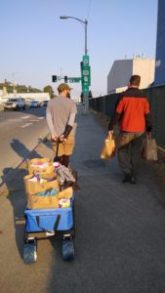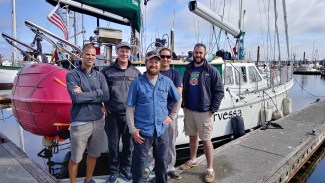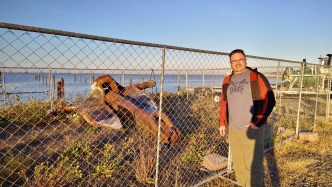 The wisdom we gleaned from friends, books, acquaintances, and good old hearsay was that the Washington and Oregon coast would be among the most difficult part of our multiyear voyage. So we decided that our still very small kids would not come on the water route of this part of the trip. Tom promptly went about putting together a crew of sailing friends who were ready and excited to be beaten up with long days, heavy winds, and high seas.
The wisdom we gleaned from friends, books, acquaintances, and good old hearsay was that the Washington and Oregon coast would be among the most difficult part of our multiyear voyage. So we decided that our still very small kids would not come on the water route of this part of the trip. Tom promptly went about putting together a crew of sailing friends who were ready and excited to be beaten up with long days, heavy winds, and high seas.

 Two of Tom’s oldest and dearest friends, Ian and Lucas, came out from Seattle and Edmonton to help take the boat from Anacortes out to Neah Bay at the tip of the Olympic Peninsula. They helped not only with the delivery to Neah Bay, but also with organizing the boat, completing the final to-do and to-fix list, and keeping Tom calm. Ian and Lucas said their farewells as four new crew members came out from Bellingham, Whidbey Island, Anacortes, and Utah to make the passage down the coast to San Francisco.
Two of Tom’s oldest and dearest friends, Ian and Lucas, came out from Seattle and Edmonton to help take the boat from Anacortes out to Neah Bay at the tip of the Olympic Peninsula. They helped not only with the delivery to Neah Bay, but also with organizing the boat, completing the final to-do and to-fix list, and keeping Tom calm. Ian and Lucas said their farewells as four new crew members came out from Bellingham, Whidbey Island, Anacortes, and Utah to make the passage down the coast to San Francisco.
 Their weather window was mostly good, but it was not an uneventful passage. They rounded Cape Flattery under good conditions and had fair winds the first few days to allow everyone to get their sea legs. The wind then began to increase dramatically, and they sought shelter in Newport, Oregon for a night. Wanting to catch a good weather window for getting around Cape Mendocino, they headed out again, only to be met off the coast with an un-forecast gale. They decided to tuck into the nook of Port Orford for the night to escape the wind and seas, but it meant spending an hour and a half sailing up into 37-knot winds before the shelter of the point allowed them a respite and a good night’s sleep.
Their weather window was mostly good, but it was not an uneventful passage. They rounded Cape Flattery under good conditions and had fair winds the first few days to allow everyone to get their sea legs. The wind then began to increase dramatically, and they sought shelter in Newport, Oregon for a night. Wanting to catch a good weather window for getting around Cape Mendocino, they headed out again, only to be met off the coast with an un-forecast gale. They decided to tuck into the nook of Port Orford for the night to escape the wind and seas, but it meant spending an hour and a half sailing up into 37-knot winds before the shelter of the point allowed them a respite and a good night’s sleep.
 After that, it was just a tired slog down the California coast, motoring, sailing, and motor-sailing as the wind dictated. For most of the trip, they generally stayed between 10 and 20 miles offshore, with the greatest distance one night at 30 miles off and a few times coming in as close as 5 miles. The abundance of sea life was unforgettable: sea lions, dolphins lit up by the water’s bio-luminescence, and so many humpback whales that the boys lost count after 50. They were thrilled to pass under the Golden Gate Bridge at 5:30 p.m. on the 7th, tie up at the first marina on the right, shower, and go out for dinner on their swaying legs.
After that, it was just a tired slog down the California coast, motoring, sailing, and motor-sailing as the wind dictated. For most of the trip, they generally stayed between 10 and 20 miles offshore, with the greatest distance one night at 30 miles off and a few times coming in as close as 5 miles. The abundance of sea life was unforgettable: sea lions, dolphins lit up by the water’s bio-luminescence, and so many humpback whales that the boys lost count after 50. They were thrilled to pass under the Golden Gate Bridge at 5:30 p.m. on the 7th, tie up at the first marina on the right, shower, and go out for dinner on their swaying legs.
 The boys learned the ropes quickly (and there are a lot of ropes, ahem “lines,” on this boat), figured out the hard way the best sail combinations after being overpowered a few times, and generally had a good – but exhausting – time. In Tom’s words “We didn’t break anything expensive,” so that’s a success (the steering wheel did break a few times, but they fixed it underway and then more securely while at dock in Newport, and we do have three back up methods of steering after all!). Everybody contributed, and everybody learned – whether it was how to best use a mizzen sail, how to read radar, or how to cook in 8-foot seas. It will no doubt reserve a special place in the memories of all aboard.
The boys learned the ropes quickly (and there are a lot of ropes, ahem “lines,” on this boat), figured out the hard way the best sail combinations after being overpowered a few times, and generally had a good – but exhausting – time. In Tom’s words “We didn’t break anything expensive,” so that’s a success (the steering wheel did break a few times, but they fixed it underway and then more securely while at dock in Newport, and we do have three back up methods of steering after all!). Everybody contributed, and everybody learned – whether it was how to best use a mizzen sail, how to read radar, or how to cook in 8-foot seas. It will no doubt reserve a special place in the memories of all aboard.
 Our trek in the land yacht down the coast was no less rocky and exciting. We began our journey in the evening and spent the first night at a noisy rest stop off of I-5. The highs of the following day were visits with Tom’s aunt and uncle in Vancouver and my cousin in Portland (pictures below). The lows of that day were losing the cat not once but twice! Luckily, she was also found twice, but not before there were considerable tears and heartache. A post shall follow eventually.
Our trek in the land yacht down the coast was no less rocky and exciting. We began our journey in the evening and spent the first night at a noisy rest stop off of I-5. The highs of the following day were visits with Tom’s aunt and uncle in Vancouver and my cousin in Portland (pictures below). The lows of that day were losing the cat not once but twice! Luckily, she was also found twice, but not before there were considerable tears and heartache. A post shall follow eventually.
 Getting used to the RV, learning a new environment, and controlling their excitement and overwhelm was difficult for the kids, and therefore also difficult for us. It was not easy to get used to a smaller space (yes, the boat is small, but it is 40 feet long and 13 feet wide to the RV’s 32 foot length and 8 foot width). Every night, both the couch and table had to convert to beds, and every morning convert back. None of us was necessarily on our best behavior because of the newness and the stress. And for my parents, this was the beginning of an 18-month North American journey, so they also had the stress of a new beginning in the same way we did way back in June when we started out on the boat.
Getting used to the RV, learning a new environment, and controlling their excitement and overwhelm was difficult for the kids, and therefore also difficult for us. It was not easy to get used to a smaller space (yes, the boat is small, but it is 40 feet long and 13 feet wide to the RV’s 32 foot length and 8 foot width). Every night, both the couch and table had to convert to beds, and every morning convert back. None of us was necessarily on our best behavior because of the newness and the stress. And for my parents, this was the beginning of an 18-month North American journey, so they also had the stress of a new beginning in the same way we did way back in June when we started out on the boat.
 But the upside was all the amazing places we got to stop and see. My mom did a phenomenal job planning some wonderful places for us to stop – with beaches and forests for the kids to play in and plenty of space to ride their bikes. Cape Lookout State Park with its phenomenal beach, Honeyman State Park with its sand dunes, Jedediah Smith State Park at the Redwoods with its hikes and visitors centers, and Chabot East Bay Regional Park in the Castro Valley with its beautiful eucalyptus trees.
But the upside was all the amazing places we got to stop and see. My mom did a phenomenal job planning some wonderful places for us to stop – with beaches and forests for the kids to play in and plenty of space to ride their bikes. Cape Lookout State Park with its phenomenal beach, Honeyman State Park with its sand dunes, Jedediah Smith State Park at the Redwoods with its hikes and visitors centers, and Chabot East Bay Regional Park in the Castro Valley with its beautiful eucalyptus trees.
 So, where are we now? After a whirlwind stay in the Bay Area cleaning up the boat, visiting friends and family, and waiting for our weather window, Tom and I left Alameda (San Francisco Bay) at 5:00 a.m. on Friday the 14th. We had overnights in Santa Cruz and Pebble Beach, neither of which offered us comfortable night’s sleeps due the surge and ocean swells. We’re currently in the beautiful, funky, and incredibly friendly Morro Bay (where we slept a deep and peaceful 11 hours last night!) and plan to leave early on Tuesday morning to head down the coast and round Point Conception, the “Cape Horn of the Pacific.” Wish us luck!
So, where are we now? After a whirlwind stay in the Bay Area cleaning up the boat, visiting friends and family, and waiting for our weather window, Tom and I left Alameda (San Francisco Bay) at 5:00 a.m. on Friday the 14th. We had overnights in Santa Cruz and Pebble Beach, neither of which offered us comfortable night’s sleeps due the surge and ocean swells. We’re currently in the beautiful, funky, and incredibly friendly Morro Bay (where we slept a deep and peaceful 11 hours last night!) and plan to leave early on Tuesday morning to head down the coast and round Point Conception, the “Cape Horn of the Pacific.” Wish us luck!








Was the wind fairly consistent? No westerlies all pretty much NW? So I guess the DDW situation on a coastal run south makes for something of a roller-coaster ride. I would think the mizzen helps stabilize the stern and aid in steering. DDW must be a bit like surfing in 8-10 foot seas and 25 knots of wind…,not to mention the California current. You anchored more than I thought you would and still made great time. Sandi, the sand dunes in Oregon are the best, In fact the whole Oregon coast is wonderful…,but it does get windy. (As I think “the boys” found out).
Robert, the wind hasn’t been particularly consistent, unfortunately, and with the exception of yesterday (around Point Conception), we actually haven’t seen as much wind as we would have liked. We’ve made good ground under motor, but we need more than 5 knots of wind to get this heavy boat sailing at a reasonable clip, especially when we needed to cover such big distances. Yesterday, we had 15-20 knots on the starboard quarter for the better part of the day, which gave us a great sail south and steadied the motion a lot. Half way between Point Arguello and Point Conception, the wind piped up to a sustained 28 with gusts to 31, which was awfully exciting with Conception’s big swells. Today we had hoped to have a good sail to Santa Barbara, but we didn’t see more than 4 knots all day! Sigh.
So glad to learn that journey is going well.
Ahhhhhh! I didn’t get cranky or grouchy or feel pressed in at all–that’s the beauty of my vantage. (Cranky, grouchy–well, yes, but not because of cramped space or misbehaving ocean waves.) You all are much more flexible and resilient than I am!
This voyage is simply ADVENTURE WRIT LARGE! I love every word you’ve posted. Love the lost-and-found cat stories. Especially the “found” parts.
I’m ready for you to weigh anchor and head south! YAY!!!!
Thanks, Vicki. We’ve officially hit southern California now, and around currently surrounded by the lights and traffic of Santa Barbara. Heading another 75 miles down the coast again tomorrow, deeper into urbania!